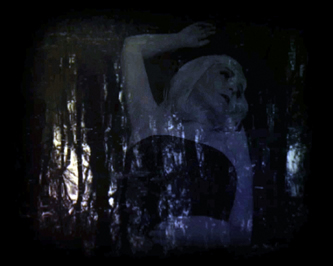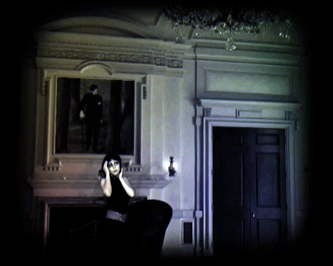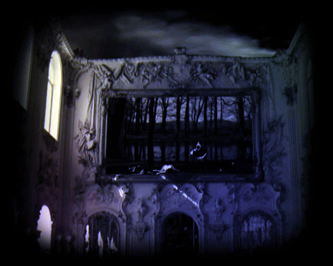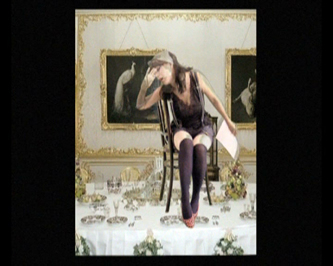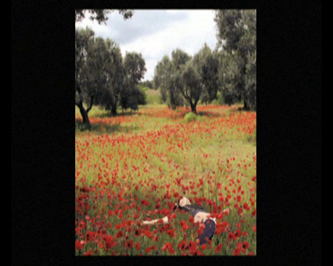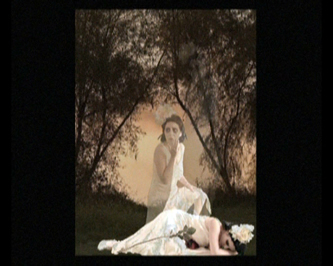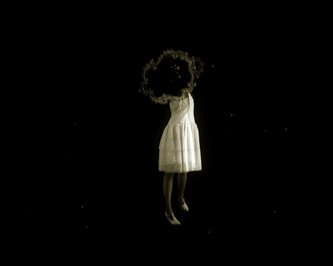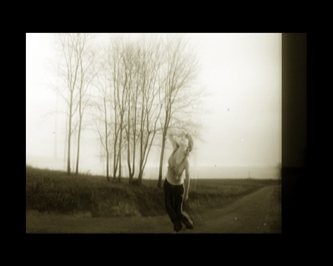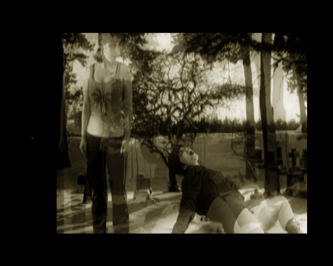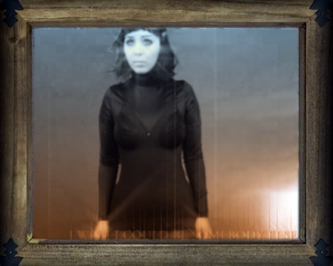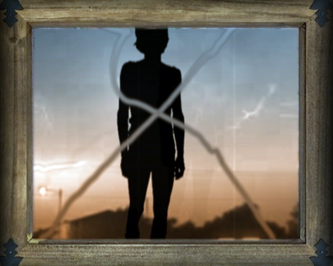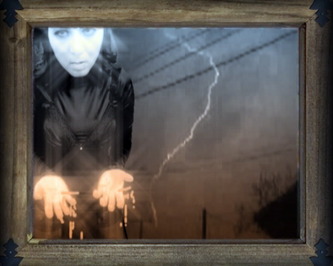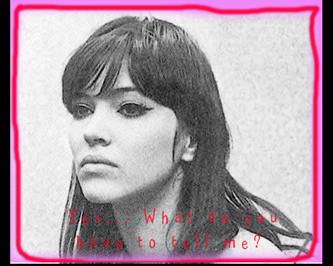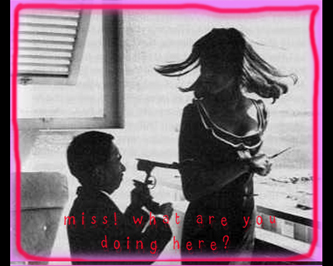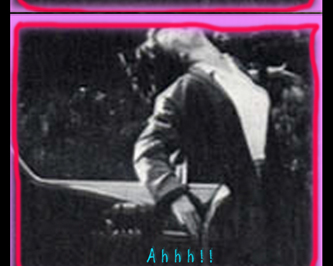In her films, Patricia Reinhart critically examines processes of subjectification and practices of constructing and superimposing real inequalities and binary gender rules. Based on research-oriented practice from an artist’s perspective while drawing from trans-disciplinary literature, art history, film theory, psychology and sociology sources, she delves into the complexity of human behaviour with regard to gender-specific constructs. Female identity as an ongoing process of negotiation between self-image and images of others, between gender norms, role models and cultural ideas associated with femininity, is the engine that drives her cinematic work.
In a productive engagement with contemporary economies of image and gaze, Patricia Reinhart further develops cinematic techniques of the practice she calls “Ciné Collage” – inspired by Chris Marker’s political science fiction La Jetée (1962), assembled from photographic stills. In her endtime scenario aesthetic, she produces films reminiscent of Andrei Tarkovsky and adapts visual methods of the projective Rorschach (inkblot) test used in psychodiagnostics for cinematic sequences that function as reflections, giving shape to the idea of manifestations as mirror images and critically reflecting on Jacques Lacan’s theses on the formation of the subject – the mirror stage as formative of the function of the I. Patricia Reinhart’s method of combining selected still images from her image archive creates a constant struggle between abstract patterns and figurative bodies or landscapes, of flora and fauna on the film surface, beyond a heteronormative determination of film towards its emancipatory potential as a speculative realm to bring us closer to new narratives.
Patricia Reinhart’s filmmaking is a “One-Woman Production”. She herself is author, actress, photographer, cinematographer, director, editor and, she is involved in all film studio processes, in stagings by the pool, within landscapes, at the shore or in public spaces, seeing these as contributing to her integrity as an artist. While her beginnings were characterised by a playful spontaneity and an irrepressible desire to study character and articulate gestures and facial expressions of social, historical and literary female figures and roles – including the pose – as an intermediate zone between suggestion and attention, as an exemplary figure of transition, as an interweaving of self-dramatisation and imaging – to which she gives communicative weight in her films. Her current work is of an epic conceptuality.
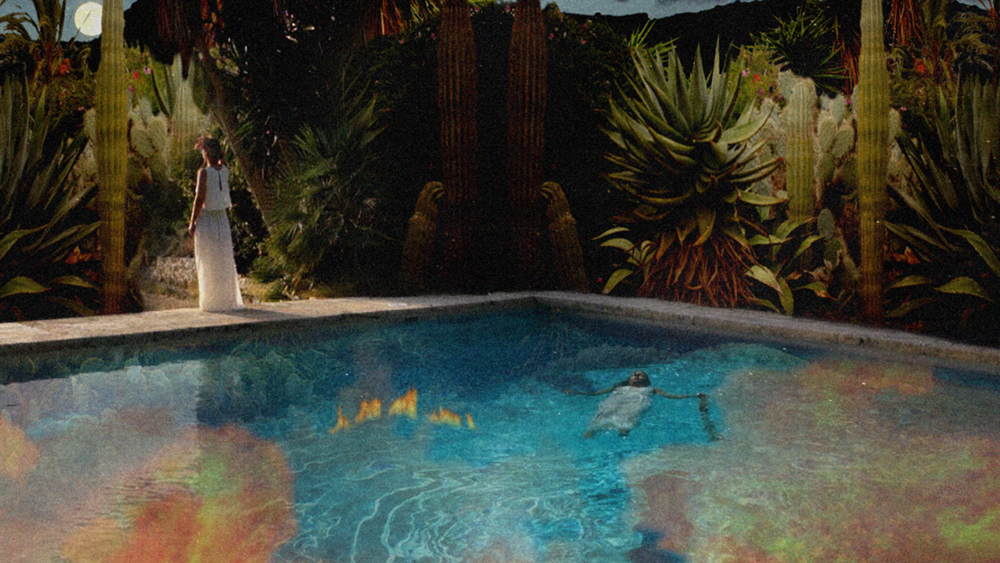
Anoir and the Woman in the Garden (2015–2017) is one of the major works in Patricia Reinhart’s cinematic oeuvre – a film of great epic power, which explores the beauty of ethical political values (embodied by a woman in a white dress), the power ego (represented by a peacock), apocalyptic doom (visualised by an explosive inferno of terror) and attempted solutions after the end of the world in the form of a naked woman emerging from the sea. She represents the drawn image of a version of the future. Cross-references to Greek mythology, in which Europa, daughter of King Agenor, was abducted by Zeus, who was transformed into a bull, outline the transition from a patriarchal to a matriarchal order. Images of statues depicting those women as warriors, a female figure referencing the painter Frida Kahlo in a labyrinthine garden of phallus-like burning cacti (image of the female artist rebelling in a patriarchal system) or in front of a bay with a mirror in her hand next to lilies symbolic of fertility, scenes of a mother with a baby in the middle of a garden of paradise (the filming/location material originates from Monet’s garden in Giverny), in whose scene a hell reflected in a mirror crystallises, are stretched into dense image and sound sequences.
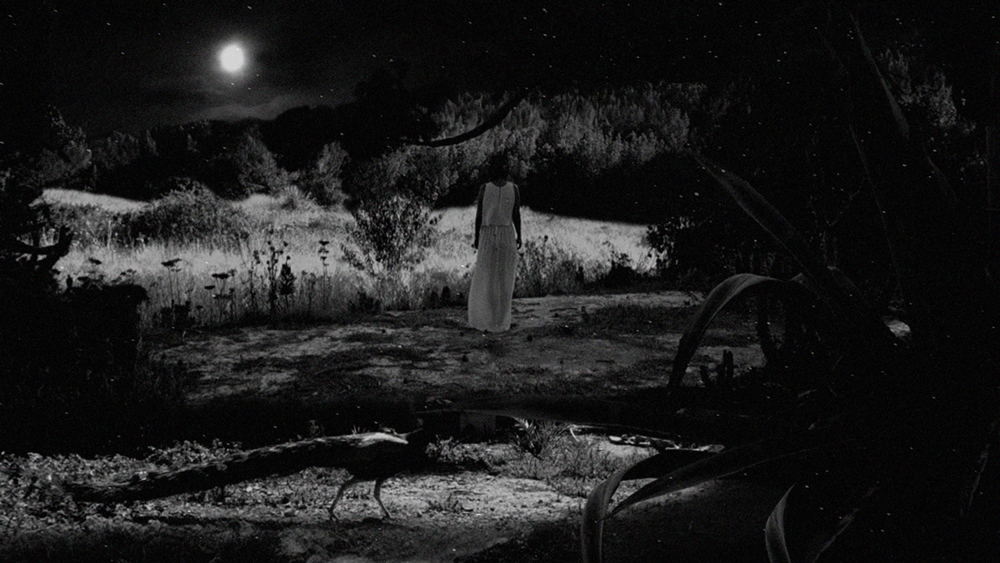
Anoir and the Woman in the Garden is composed as a visual piece of music and rhythmically intercut with the electronic soundscape of Frédéric D. Oberland, whose original sound Patricia Reinhart altered through lengthened distortions, creating another dimension to captivate the senses through the temporal transfer and acoustic mirror thus manifested. Through the interplay of performance, film and sound techniques, the film as organism gains magical intensity.


In her early productions, Patricia Reinhart shows how various systems, actions and emotions can overlap, how gestures and feelings are integrated into relationships. She develops techniques that allow her figures (mainly embodied by herself as she enters the scene in multiple roles) to interact. In her search for interfaces between individual life and the cultural memory of humanity, in particular the situation of women, Patricia Reinhart employs a decidedly vigilant, poetic and political use of the medium of film and its technical innovations.
Ciné Collage is thus the designation for a layering technique that transfers collage-making methods to film, as it were, creating a metafictional mirroring of scenes through the montage of images. When Patricia Reinhart uses different sources and shifts meaning poetically through Ciné Collage, new visual forms emerge that collide with cinematic conventions. As a painter who works in layers she transfers her self conception to the medium of film, thereby gaining depth of colour and form. In addition to her painting practice, she derives her cinematographic vocabulary from her considerable acting skills; parallel to her painting studies, she studied acting. To avoid copyright conflicts, she decided early on to use her own material, her own still images and video recordings. In the meantime, she has an extensive archive of up to 500 photos per theme. She repeatedly photographs single frames to break the illusion of continuity of the finished film, which consists of montages of frozen, still images that recall the stillness of the filmstrip, a kind of necrosis that underlines the incredible vitality of her films.

With a keen eye, Patricia Reinhart analyses inequalities that manifest themselves in real life and are reflected in literature, film and art, appealing to emancipatory processes as she herself performs, slipping into countless female roles as she embodies historical and literary female figures such as Shakespeare’s Ophelia or Dreyer’s Joan of Arc, posing questions of female identity in specific social contexts or using them as metaphors for understanding social phenomena. After examining silent movies, their techniques in creating pictorial illusions, and animated film, Patricia Reinhart became intensively involved with Nouvelle Vague, especially Jean-Luc Godard and the female characters portrayed by Anna Karina, in particular in Vivre sa vie (1962), Alphaville (1965) and Pierrot le fou (1965). “This particular film aesthetic of the 1960s brought me to my self-portraits, which are made exclusively in the Paris Photomatons”, says Patricia Reinhart, bridging a connection to her photographic work. “In addition, I studied the Untitled Film Stills by Cindy Sherman [from the years 1977 to 1980], which subsequently inspired me to create my own film sequences.”
Images not only (re)produce the visible, but also suggest dominant norms and normalities. The feminist film theorist Kaja Silverman’s analysis of the gaze regimes that determine what appears on the screen in the cultural image repertoire provides a clue about the parameters of representation, how to deal with being mirrored and how to resist appropriation by such reflected images. From a representation- critical point of view, Patricia Reinhart develops procedures for arriving at other images, images which, through her techniques, occupy a productive distance from what has been seen before. Like the reinventor of cinema forms Chantal Akerman, Patricia Reinhart develops her own dramaturgy from a feminist point of view as she transgresses genre boundaries with a pronounced sense of durability and experience across time.
The following three works are taken from an apocalyptic film cycle that Patricia Reinhart started over 10 years ago in order to portray a possible end-of-the-world scenario. This series also includes films such as: Die ihr Brot mit Tränen aß (Requiem for an Unendurable Paradise) (2013/2014) and Kirkirerland (2008). The question is addressed: How can one cope with certain death; how does one behave at the end of the world? Partly it is acceptance, partly it is a struggle for survival or a hopelessness in search of a different future that we encounter in the films. This is made visible both in the complex iconography of the images and in the use of special cinematographic techniques.
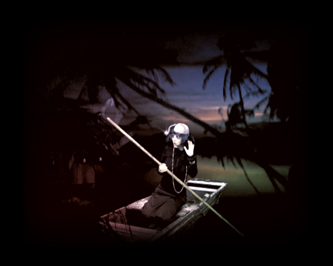
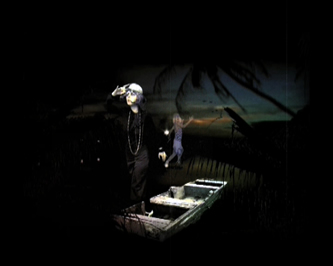
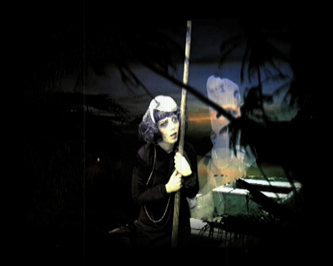
Patricia Reinhart’s own body as a performative agent refers not only to what is human and alive in a biological sense – and therefore also mortal – but to historical as well as contemporary manifestations of an ever-increasing complexity of agency. To make new narratives imaginable and create space for an interconnected, complicated and complex reality, Patricia Reinhart uses the metaphor of death. She seems driven to always be one step ahead.
Patricia Reinhart focuses on two aspects at the same time: on the one hand, her authenticity as an artist, and on the other, prevailing social conditions for women, spanning these into a cultural-historical genealogy. The contradiction between the precariousness of her protagonists and the desire for an opulence of images is striking. This contradictory conundrum can be compared with Michel Foucault’s concept of heterotopia, with the help of which she establishes a relationship between the utopian, imaginary dimensions of her real, unrelated images and their material, tangible dimensions.
Heterotopia can be seen in the context of Patricia Reinhart’s Ciné Collages applied to the three-channel video installation Ein Nachtstück (2011/2012) as a visualisation of imaginary places and parallel worlds that create space for new experiential horizons.
The Ciné Collage as heterotopia creates an illusion of apparent (nightmarish) dreaminess. “In Ein Nachtstück a female figure appears in Peter Doig’s canoe”, says Patricia Reinhart, lending insight into existing references woven into her film sequences like subtle quotations.
These strands act as threads that intertwine. Shot in Paris, Patricia Reinhart’s visualisation shows how the past survives in the form of an “historical present” in architecture, demonstrating the way in which past and present occur simultaneously. The act of perception becomes a revelation, a moment of difference. I know that what I am looking at is not real, yet it brings me closer to reality. Patricia Reinhart’s artistic independence consists in also being critical of the techniques she uses and in confronting them with fantasies of feasibility.
In the process of cinematic elaboration, she is indeed a visual eccentric, working without a script, using sketches to visually maximise her films, in which still images and video sequences join together like elementary particles even as categorical demarcations dissolve. Her explosive visual creativity will give rise to essayistic treatises of an unpredictable work and a sceptical attitude towards the modern belief that reality can be grasped through image constructions.
In her early short films, Patricia Reinhart stages humorous portraits, everyday scenes and slapstick imbued with the charm of the silent film era. She has mastered the art of transformation. With her acting talent and a reliable comedic sensibility, beautiful grimaces hark back to the early days of film in self-made miniature sets with simple props. She uses the media practices that photography and film have in common, namely focusing from a certain point of view to stage and manipulate through framing and the options of self-reflection of one’s own media process. Her research on the filmmaker Maya Deren, on her experimental films from the 1940s and their development of the specific art form of video dance, is followed by an intensive examination of Maya Deren’s film theories and a cinematic manner of thinking that opens up intersensory worlds. As in Maya Deren’s films, Patricia Reinhart’s cinematic oeuvre includes creative action in generous amounts, gaining gravitas through the manipulation of time and space, both in preand post-production.
Patricia Reinhart operates the camera using a tripod and self-timer; the intimate moment (of being completely alone), the search for the authentic image of being, is essential during the shoot and the staging in public spaces. In the studio, she arranges photo sequences in the manner of Ciné Collage, which enables her to enter the picture herself several times in a kaleidoscope-like manner and to resist a hegemonic visual dispositive, displaying a feminist impetus in altering the rules of the gaze, relations of dominance, conventions of perception and visualisation. Following the film theorist Kaja Silverman, the concept of the gaze regime can also be used to grasp the (re)effect of perceptual structures on the constitution of the subject and thus on gender; in this respect, this insistent confrontation with conventional gaze norms can be seen as a cultural practice. Poetic image sequences emerge from post-dramatic aesthetics developed in this way, which become film through montage – at a crossroads between performance, art and film history.
The work 13 Poèmes visibles (Ophélia & Avant de mourir) (2011) shows how film analysis and cinematic production techniques are synergistic. In the original, the thirteen Super-8 films run in parallel in 8–35 second loops as a spatial installation, forming a nearly orchestral arrangement. The underlying concept of this symphonic encounter of thirteen portraits of women is inspired by the publication Speaking about Godard, based on conversations between the feminist film theorist Kaja Silverman – via post-structuralism and psychoanalysis – and the avant-garde filmmaker Harun Farocki about Godard’s most important films and their formal and theoretical innovations. In the chapter Nana is an animal, Godard’s film Vivre sa vie is referenced in a reading as they discuss each scene in detail. Patricia Reinhart ties in with their film analyses: “This conversation led me to the images and functioned as a tool of sorts, so that I saw in it a new order for me that provided me with a structure to give my ideas a conceptual ‘corset of form’ which I needed for the Poèmes.”
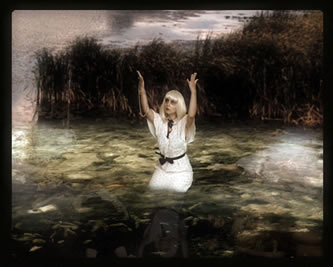
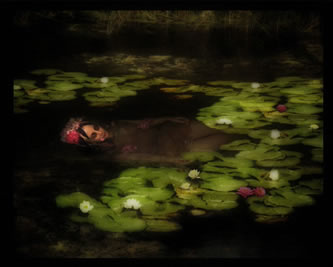
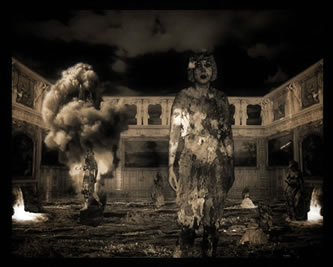
In the analogue experimentation with Super-8 film material and in the conscious use of the fragile medium of film (tear, burn-through, wear), evidence of use is employed as an aesthetic form to represent the drama of actual human fragility. Patricia Reinhart uses historical, literary and cinematic references to trace a clear path to the present. Her scene featuring Joan of Arc refers to the 1928 historical film La Passion de Jeanne d’Arc by Carl Theodor Dreyer. In 1962, Jean-Luc Godard made his fourth feature film Vivre sa vie: film en douze tableaux, an essayistic, documentary account of the everyday life of the young prostitute Nana, in which his wife at the time, Anna Karina, played the leading role. About 14 minutes into the film, we see Nana sitting in a cinema watching a particularly pointed, transcendental scene from Carl Theodor Dreyer’s masterpiece starring Maria Falconetti. It shows Joan of Arc waiting to die. Patricia Reinhart refers to these scenes from Godard’s film and Dreyer’s masterpiece. She is interested in the drama of this female figure who, although she does everything right in the male world in which she engaged and helped France to victory, was accused of heresy, condemned to death and executed.
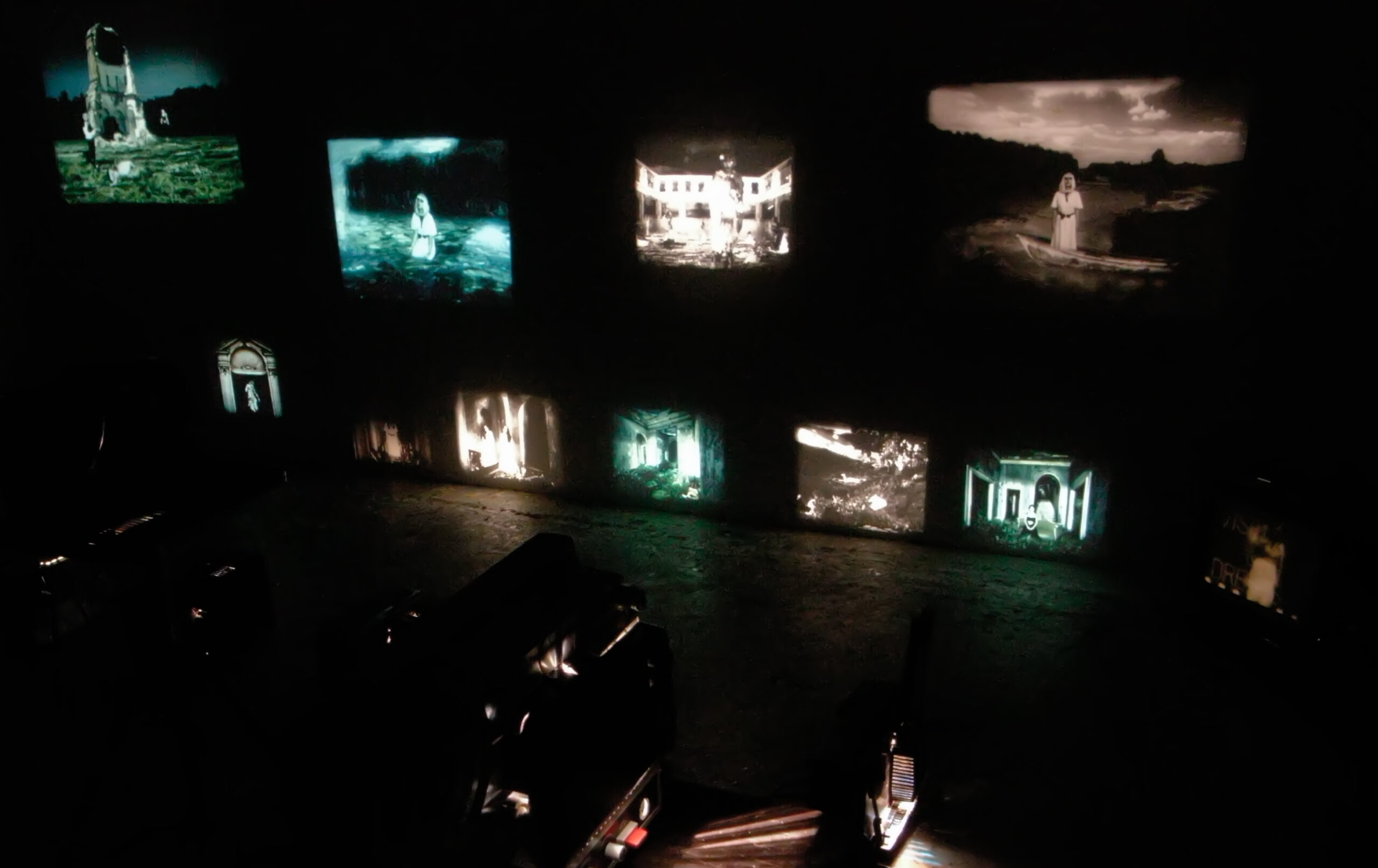
This image of a woman who died unjustly and at the same time accepted it herself in the face of her religious upbringing forms one of a total of thirteen sequences inspired in their staging by silent film stars such as Asta Nielsen, Lyda Borelli or Pola Negri. Extravagant women in the limelight who were considered divas and revered as “divinities” and whose self-confident ambitions for self-empowerment often ended dramatically with an untimely death. The subtexts written for them deal with death, redemption and confrontation with others – referencing Virginia Woolf’s A Room of One’s Own (1929) in the process – raise questions as to how perspectives on freedom, personal responsibility and visions emerge, address violence and influence victim and perpetrator roles, male and/or female. We meet self-determined women who fail due to external circumstances. A short sequence of 13 seconds shows a woman being shot and blood flowing from her upper body. “Aren’t all dreams and visions immediately destroyed within this system?”, asks Patricia Reinhart.
From what entanglements is it necessary to free oneself? Why are historical operas and plays still performed in versions in which the heroines are often doomed to die? The character of Ophelia, which she stages on film, refers to a painting by John Everett Millais (1852) and to Shakespeare’s Ophelia in Hamlet (around 1600–1602), which is one of William Shakespeare’s most controversial works to date. Various adaptations exist in which Ophelia and Hamlet’s love affair is being questioned. Asta Nielsen took on the title role in 1921 and was the first actress to play a woman disguised as a man, altering Hamlet’s gender. “This film with Asta Nielsen led me to the characters – especially her own strange interpretation of the theatrical transposition, in particular her stiff arm movements from top to bottom in one scene”, Patricia Reinhart explains, pointing to her intensive study of the silent movie stars, whose careers ended abruptly with the switch to talking movies. // Excerpts from Ursula Maria Probst’s text featured in the monograph ‚Patricia Reinhart,‘ published by Verlag für moderne Kunst, Vienna, 2022.
Filmography:
2017 Anoir and the Woman in the Garden / Ciné Collage, HD Video, sound / 9’47’’, 3 + 1 AP, ES/FR
2014 Die ihr Brot mit Tränen aß (Requiem for an Unendurable Paradise) / single-channel video installation, vinyl and record player / Ciné Collage, sound / 5’45’’, 3 + 1 AP, ES/FR
2014 Le Radeau de la Méduse / Ciné Collage, no sound / 0’24’’, 3 + 1 AP, FR
2012 Ein Nachtstück / three-channel video installation / Ciné Collage, no sound / 5’00’’, 3 + 1 AP, FR/AT
2011 13 Poèmes visibles (Ophélia & Avant de mourir) / Ciné Collage and Super-8 film, no sound / 0’08’’–0’35’’, 5 + 2 AP, HU/AT
2008 Nocturne in Black / Ciné Collage, sound / 3’22’’, 3 + 1 AP, AT / courtesy: the artist and Albertina, Vienna, AT
2008 Kirkirerland / Ciné Collage and Super-8 film, no sound / 1’10’’, 5 + 2 AP, AT / courtesy: the artist, Bibliothèque nationale de France, Paris, FR, and Ursula Blickle Video Archiv – Belvedere, Vienna, AT
2007 4. Akt Lyda’s Death / Ciné Collage, sound / 3’50’’, 3 + 1 AP, AT
2006 Untitled / Silentmovie / Ciné Collage, sound / 3’00’’, 3 + 1 AP, AT
2006 Der bittere Beigeschmack / Ciné Collage, sound / 3’00’’, 3 + 1 AP, AT
2005 Heroes & Loser / Ciné Collage, sound / 3’00’’, 3 + 1 AP, AT
2004 The Adventures of Rick Castle and Santa Fee / Ciné Collage, sound / 2’30’’, 3 + 1 AP, AT
2004 Paris mon amour / Ciné Collage, sound / 3’00’’, 3 + 1 AP, AT
2004 Die Sonne meines Lebens / Ciné Collage, sound / 3’12’’, 3 + 1 AP, AT
2004 Zug / Ciné Collage, sound / 1’30’’, 3 + 1 AP, AT
2004 Barbara & Paul / Ciné Collage, sound / 2’30’’, 3 + 1 AP, AT
2004 Blindness / DV, sound / 3’00’’, 3 + 1 AP, AT
2004 Triple Tak / Ciné Collage, sound / 4’30’’, 3 + 1 AP, AT
2004 Fight / DV, sound / 1’00’’, 3 + 1 AP, AT
2004 Something’s Stilling / DV, sound / 3’30’’, 3 + 1 AP, AT
2004 Depeche Mode Dancer / DV, sound / 2’30’’, 3 + 1 AP, AT
2003 Kanikula / DV, sound / 7’00’’, 3 + 1 AP, HU/AT
2003 Chercher le destin / DV, sound / 7’00’’, 3 + 1 AP, FR/AT
2002 A.M. / Super-8 film and DV, sound, 8’00’’, 1 + 1 AP, AT
2001 Pont Neuf / Super-8 film, no sound, 3’20’’, 1 AP, FR
2001 Pigalle / Super-8 film, no sound, 3’20’’, 1 AP, FR
2001 Métro / Super-8 film, no sound, 3’20’’, 1 AP, FR
